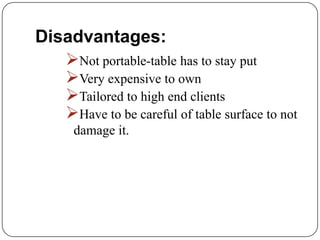Surface computing
- 2. Introduction: Surface computing is the term in which traditional GUI elements are replaced by intuitive, everyday objects. Instead of a keyboard and mouse, the user interacts directly with a touch-sensitive screen. It is a form of computing that offers a “natural way of interaction with information” rather than the traditional user interface.
- 3. History: 2001:Microsoft researchers “Steve bathiche and Andy wilson” developed idea of interactive table that could understand the manipulation of physical pieces. •2003:First prototype model named T1 was born
- 4. Cont 2005:Its form factor tub prototype was designed •2007 :Finally interactive tabletop device was built that brings both the physical and virtual worlds into one
- 5. Microsoft surface: It is a computer that interacts with the user through the surface of an ordinary object. It is a 30 inch table top display which allows several peoples to interact independently or simultaneously. With surface we can grab objects with our hands and move information between objects with natural gestures and touch.
- 7. Working: The screen uses multiple infrared cameras beneath the screen/table top to sense object, physical touch etc.. The information are processed and displayed using rear projection. It consists of: Touch surface Cameras CPU Projector
- 9. Touch surface: It is a multi touch screen that processes multiple inputs and recognizes objects. Infrared: Once an object touches the table top the light reflects and is taken up by infrared camera’s. CPU: It consists of core 2 duo processor,2GB of RAM and 256 MB graphics card Projector: It uses DLP light engine for rear projection.
- 10. Key attributes: Direct interaction Multi touch Multi-user Object recognition
- 11. Direct interaction: The ability to grab digital information with handsinteracting with mouse gestures and not with mouse or keyboard. Multi-user: It allows many people to experience collaborative, face-to-face computing experience.
- 12. Multi touch: The ability to recognize multiple points of contact at the same time. Object recognition: Physical objects can be placed on the screen to trigger different types of digital responses.
- 13. Who are using surface today: Current customers are: AT&T mobile Rio all suite hotel & casino in las vegas Sheraton hotel Disney innovations house in california Hotel 1000 in seattle Starwood hotels and resorts worldwide.
- 14. Advantages: Multi users collaborative effort of users interacting Seamless-no wires or USB ports Instant download/upload of photos. Users have more control of technologyordering food or manipulating photos fast. User friendly
- 15. Disadvantages: Not portable-table has to stay put Very expensive to own Tailored to high end clients Have to be careful of table surface to not damage it.
- 16. Conclusion: Surface computer is a perfect computing device which is user friendly to all kinds of user by having basic information and very smart and unique features which none other computer has and it can be called as FUTURE COMPUTER.
- 17. THANK YOU
















